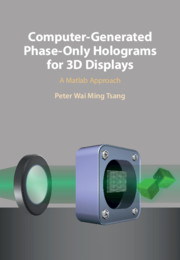Book contents
- Computer-Generated Phase-Only Holograms for 3D Displays
- Computer-Generated Phase-Only Holograms for 3D Displays
- Copyright page
- Contents
- Preface
- Acknowledgments
- 1 Introduction to Digital Holography
- 2 Fast Methods for Computer-Generated Holography
- 3 Generation of Phase-Only Fresnel Hologram
- 4 Conversion of Complex-Valued Holograms to Phase-Only Holograms
- 5 Applications of Phase-Only Hologram in Display, Holographic Encryption, and Steganography
- Index
- References
2 - Fast Methods for Computer-Generated Holography
Published online by Cambridge University Press: 07 January 2021
- Computer-Generated Phase-Only Holograms for 3D Displays
- Computer-Generated Phase-Only Holograms for 3D Displays
- Copyright page
- Contents
- Preface
- Acknowledgments
- 1 Introduction to Digital Holography
- 2 Fast Methods for Computer-Generated Holography
- 3 Generation of Phase-Only Fresnel Hologram
- 4 Conversion of Complex-Valued Holograms to Phase-Only Holograms
- 5 Applications of Phase-Only Hologram in Display, Holographic Encryption, and Steganography
- Index
- References
Summary
In this chapter, a number of quick methods for generating digital Fresnel holograms are introduced. For an object comprising a small number of depth planes, the layer-based method implemented in the Fourier space is preferred for fast hologram generation. The point-based method is more suitable for generating objects with a large number of object points that are scattered over a wide range of distances from the hologram plane. To enhance the speed of hologram generation with the point-based method, different variants and sizes of the look-up-table (LUT) algorithms to trade-off computation time are described. A number of methods based on the concept of a wavefront recording plane (WPR) are presented. Being different from the LUT approach, the WRP methods speed up the hologram-generation process. Instead of generating the full hologram for each object point, only a small area of fringe patterns is computed on a WRP that is at close proximity to the object space. The computation time is substantially reduced. Further enhancement of the computation speed is attained with the warped wavefront recording plane (WWRP) method. A 3-D object image is decomposed into a 2-D intensity image and a depth map. The intensity image is used to generate an interim hologram on a WRP. Different regions of the hologram fringes on the WRP are resized according to their distances (obtained from the depth map) from the hologram plane to generate a hologram from the WRP.
Keywords
- Type
- Chapter
- Information
- Computer-Generated Phase-Only Holograms for 3D DisplaysA Matlab Approach, pp. 40 - 75Publisher: Cambridge University PressPrint publication year: 2021



